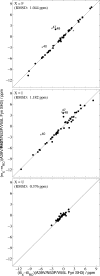Phi-value analysis of a three-state protein folding pathway by NMR relaxation dispersion spectroscopy
- PMID: 17898173
- PMCID: PMC2000424
- DOI: 10.1073/pnas.0705097104
Phi-value analysis of a three-state protein folding pathway by NMR relaxation dispersion spectroscopy
Abstract
Experimental studies of protein folding frequently are consistent with two-state folding kinetics. However, recent NMR relaxation dispersion studies of several fast-folding mutants of the Fyn Src homology 3 (SH3) domain have established that folding proceeds through a low-populated on-pathway intermediate, which could not be detected with stopped-flow experiments. The dispersion experiments provide precise kinetic and thermodynamic parameters that describe the folding pathway, along with a detailed site-specific structural characterization of both the intermediate and unfolded states from the NMR chemical shifts that are extracted. Here we describe NMR relaxation dispersion Phi-value analysis of the A39V/N53P/V55L Fyn SH3 domain, where the effects of suitable point mutations on the energy landscape are quantified, providing additional insight into the structure of the folding intermediate along with per-residue structural information of both rate-limiting transition states that was not available from previous studies. In addition to the advantage of delineating the full three-state folding pathway, the use of NMR relaxation dispersion as opposed to stopped-flow kinetics to quantify Phi values facilitates their interpretation because the obtained chemical shifts monitor any potential structural changes along the folding pathway that might be introduced by mutation, a significant concern in their analysis. Phi-Value analysis of several point mutations of A39V/N53P/V55L Fyn SH3 establishes that the beta(3)-beta(4)-hairpin already is formed in the first transition state, whereas strand beta(1), which forms nonnative interactions in the intermediate, does not fully adopt its native conformation until after the final transition state. The results further support the notion that on-pathway intermediates can be stabilized by nonnative contacts.
Conflict of interest statement
The authors declare no conflict of interest.
Figures



Similar articles
-
Identification of a collapsed intermediate with non-native long-range interactions on the folding pathway of a pair of Fyn SH3 domain mutants by NMR relaxation dispersion spectroscopy.J Mol Biol. 2006 Nov 10;363(5):958-76. doi: 10.1016/j.jmb.2006.08.047. Epub 2006 Aug 22. J Mol Biol. 2006. PMID: 16989862
-
Abp1p and Fyn SH3 domains fold through similar low-populated intermediate states.Biochemistry. 2006 Aug 29;45(34):10175-83. doi: 10.1021/bi0611560. Biochemistry. 2006. PMID: 16922492
-
Side-chain interactions in the folding pathway of a Fyn SH3 domain mutant studied by relaxation dispersion NMR spectroscopy.Biochemistry. 2005 Nov 29;44(47):15430-6. doi: 10.1021/bi051771o. Biochemistry. 2005. PMID: 16300390
-
Relaxation dispersion NMR spectroscopy as a tool for detailed studies of protein folding.Biophys J. 2009 Mar 18;96(6):2045-54. doi: 10.1016/j.bpj.2008.12.3907. Biophys J. 2009. PMID: 19289032 Free PMC article. Review.
-
Mutational investigation of protein folding transition states by Phi-value analysis and beyond: lessons from SH3 domain folding.Biochem Cell Biol. 2010 Apr;88(2):231-8. doi: 10.1139/o09-153. Biochem Cell Biol. 2010. PMID: 20453926 Review.
Cited by
-
Evidence against the "Y-T coupling" mechanism of activation in the response regulator NtrC.J Mol Biol. 2014 Apr 3;426(7):1554-67. doi: 10.1016/j.jmb.2013.12.027. Epub 2014 Jan 7. J Mol Biol. 2014. PMID: 24406745 Free PMC article.
-
Understanding the mechanism of prosegment-catalyzed folding by solution NMR spectroscopy.J Biol Chem. 2014 Jan 10;289(2):697-707. doi: 10.1074/jbc.M113.505891. Epub 2013 Nov 21. J Biol Chem. 2014. PMID: 24265313 Free PMC article.
-
Roles of beta-turns in protein folding: from peptide models to protein engineering.Biopolymers. 2008 May;89(5):380-91. doi: 10.1002/bip.20960. Biopolymers. 2008. PMID: 18275088 Free PMC article. Review.
-
Protein folding and misfolding: mechanism and principles.Q Rev Biophys. 2007 Nov;40(4):287-326. doi: 10.1017/S0033583508004654. Epub 2008 Apr 14. Q Rev Biophys. 2007. PMID: 18405419 Free PMC article. Review.
-
Theoretical and experimental demonstration of the importance of specific nonnative interactions in protein folding.Proc Natl Acad Sci U S A. 2008 Jul 22;105(29):9999-10004. doi: 10.1073/pnas.0801874105. Epub 2008 Jul 14. Proc Natl Acad Sci U S A. 2008. PMID: 18626019 Free PMC article.
References
-
- Fersht A. Structure and Mechanism in Protein Science. New York: Freeman; 1999.
-
- Palmer AG. Chem Rev. 2004;104:3623–3640. - PubMed
-
- Korzhnev DM, Salvatella X, Vendruscolo M, Di Nardo AA, Davidson AR, Dobson CM, Kay LE. Nature. 2004;430:586–590. - PubMed
-
- Korzhnev DM, Neudecker P, Mittermaier A, Orekhov VY, Kay LE. J Am Chem Soc. 2005;127:15602–15611. - PubMed
Publication types
MeSH terms
Substances
LinkOut - more resources
Full Text Sources
Other Literature Sources
Miscellaneous

